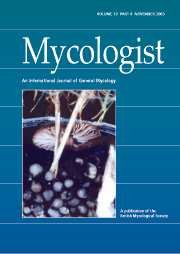Article contents
Teaching techniques for mycology: 19. A micro-dilution drop-trail method for isolating Onygenalean ascomycetes from hair baits
Published online by Cambridge University Press: 08 January 2003
Abstract
Name of fungi:Aphanoascus, Arthroderma, Auxarthron, Ctenomyces, Gymnoascus (Ascomycota: Onygenales)
Introduction: features of interest
Members of the order Onygenales produce asci within gymnothecia, which consist of a mesh of rigid interlinked hyphae. Highly characteristic appendages are often present; they may be straight or curved and branched or unbranched, and they are an important character for identification of species and genera (Currah, 1985). Despite the striking appearance of the gymnothecial appendages, their ecological role is poorly understood at present. Together with the rigid hyphae of the gymnothecium, they may protect the asci from attack by mites (Summerbell, 2000), and they may also aid dispersal by attaching the gymnothecium to the fur of small mammals. Many Onygenales producing appendages are found in the burrows of animals and feed on their hair (keratin).
- Type
- Original Article
- Information
- Copyright
- © 2002 Cambridge University Press
- 3
- Cited by




